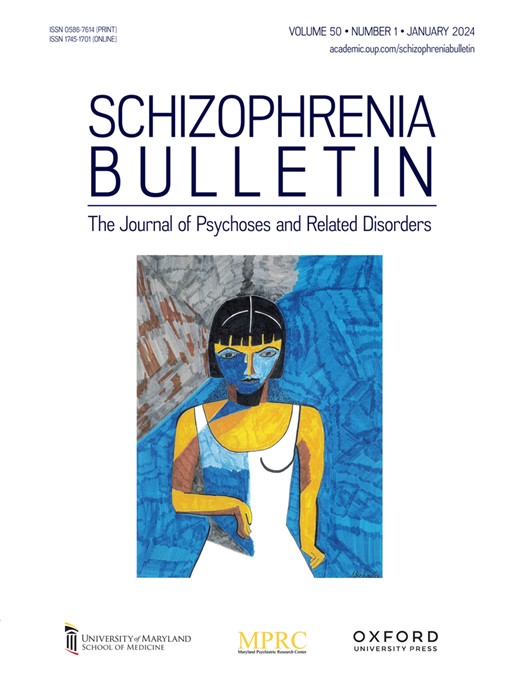Age of Onset, Brain Controllability, and Working Memory Performance in First-Episode Schizophrenia
IF 4.8
1区 医学
Q1 PSYCHIATRY
引用次数: 0
Abstract
Background and Hypothesis The onset-age of schizophrenia introduces considerable heterogeneity in cognitive functions such as working memory (WM) among patients. One of the key properties of the brain that varies with age-related development is the network-level controllability of brain state transitions. We tested the effect of onset-age on brain controllability to evaluate its impact on WM deficits in schizophrenia. Study Design We examined the average and modal controllability of the brain connectome in 85 first-episode early-onset schizophrenia (EOS), 62 younger healthy controls (yHC), 71 first-episode adult-onset schizophrenia (AOS), and 85 older healthy controls (oHC) during N-back tasks. We first detected the regions with illness and onset-age interaction in a whole-brain search, and then conducted a correlation analysis with WM performance and clinical characteristics, followed by an out-of-sample gene annotation analysis. Study Results We detected the illness*onset-age interaction in the sensorimotor network, auditory network, and subcortical network for average controllability and the default mode network, visual network, and salience network for modal controllability (p-fdr < 0.05). The interaction effects in the visual and subcortical networks primarily resulted from the AOS vs. oHC differences; the effects in the default mode network resulted from EOS vs. yHC differences. We observed no significant correlation between controllability with cognitive performance or clinical characteristics. The affected regions had preferential expression of genes relevant to synaptic signaling and neurodegenerative processes (p-fdr < 0.05). Conclusion Onset-age introduces considerable heterogeneity in the controllability over brain state transition during WM tasks among patients with schizophrenia.首发精神分裂症的发病年龄、大脑可控性和工作记忆表现
背景与假设精神分裂症的发病年龄导致患者在认知功能如工作记忆(WM)方面存在相当大的异质性。随着年龄相关的发展而变化的大脑的关键特性之一是大脑状态转换的网络级可控性。我们测试了发病年龄对大脑可控性的影响,以评估其对精神分裂症患者WM缺陷的影响。我们检测了85例首发早发性精神分裂症(EOS)、62例年轻健康对照(yHC)、71例首发成年性精神分裂症(AOS)和85例老年健康对照(oHC)在N-back任务期间脑连接组的平均可控性和模态可控性。我们首先在全脑搜索中检测出疾病和发病年龄相互作用的区域,然后与WM性能和临床特征进行相关性分析,然后进行样本外基因注释分析。研究结果在感觉运动网络、听觉网络和皮层下网络中检测到平均可控性,在默认模式网络、视觉网络和显著性网络中检测到疾病-发病-年龄的相互作用(p-fdr < 0.05)。视觉网络和皮层下网络的交互作用主要是由AOS和oHC的差异引起的;默认模式网络的影响是由EOS和yHC的差异造成的。我们观察到可控性与认知表现或临床特征之间没有显著的相关性。受影响的区域优先表达与突触信号和神经退行性过程相关的基因(p-fdr < 0.05)。结论发病年龄对精神分裂症患者WM任务中脑状态转换的可控性具有一定的异质性。
本文章由计算机程序翻译,如有差异,请以英文原文为准。
求助全文
约1分钟内获得全文
求助全文
来源期刊

Schizophrenia Bulletin
医学-精神病学
CiteScore
11.40
自引率
6.10%
发文量
163
审稿时长
4-8 weeks
期刊介绍:
Schizophrenia Bulletin seeks to review recent developments and empirically based hypotheses regarding the etiology and treatment of schizophrenia. We view the field as broad and deep, and will publish new knowledge ranging from the molecular basis to social and cultural factors. We will give new emphasis to translational reports which simultaneously highlight basic neurobiological mechanisms and clinical manifestations. Some of the Bulletin content is invited as special features or manuscripts organized as a theme by special guest editors. Most pages of the Bulletin are devoted to unsolicited manuscripts of high quality that report original data or where we can provide a special venue for a major study or workshop report. Supplement issues are sometimes provided for manuscripts reporting from a recent conference.
 求助内容:
求助内容: 应助结果提醒方式:
应助结果提醒方式:


